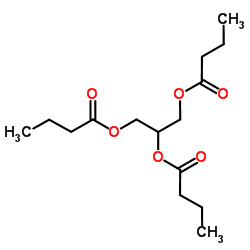butyrin

butyrin structure
|
Common Name | butyrin | ||
|---|---|---|---|---|
| CAS Number | 60-01-5 | Molecular Weight | 302.363 | |
| Density | 1.1±0.1 g/cm3 | Boiling Point | 307.5±0.0 °C at 760 mmHg | |
| Molecular Formula | C15H26O6 | Melting Point | -75 °C | |
| MSDS | Chinese USA | Flash Point | 173.9±0.0 °C | |
|
Solid lipid particles for oral delivery of peptide and protein drugs III - the effect of fed state conditions on the in vitro release and degradation of desmopressin.
AAPS J. 16(4) , 875-83, (2014) The effect of food intake on the release and degradation of peptide drugs from solid lipid particles is unknown and was therefore investigated in vitro using different fed state media in a lipolysis model. Desmopressin was used as a model peptide and incorpor... |
|
|
Biochemistry of lipolytic enzymes secreted by Penicillium solitum and Cladosporium cladosporioides.
Biosci. Biotechnol. Biochem. 78(2) , 245-54, (2014) Two distinct extracellular lipases were obtained from Penicillium solitum 194A, isolated from domestic compost, and Cladosporium cladosporioides 194B, isolated from dairy wastewater. These alkaline enzymes had molecular masses of 42 and 30 kDa, respectively. ... |
|
|
Candida rugosa lipase immobilization on hydrophilic charged gold nanoparticles as promising biocatalysts: Activity and stability investigations.
Colloids Surf. B Biointerfaces 131 , 93-101, (2015) In this work, a simple and versatile methodology to obtain two different bioconjugated systems has been developed by the immobilization of Candida rugosa lipase (CRL) on hydrophilic gold nanoparticles functionalized with 2-diethylaminoethanethiol hydrochlorid... |
|
|
Molecular cloning of a novel bioH gene from an environmental metagenome encoding a carboxylesterase with exceptional tolerance to organic solvents.
BMC Biotechnol. 13 , 13, (2013) BioH is one of the key enzymes to produce the precursor pimeloyl-ACP to initiate biotin biosynthesis de novo in bacteria. To date, very few bioH genes have been characterized. In this study, we cloned and identified a novel bioH gene, bioHx, from an environme... |
|
|
Xylella fastidiosa esterase rather than hydroxynitrile lyase.
ChemBioChem. 16(4) , 625-30, (2015) In 2009, we reported that the product of the gene SCJ21.16 (XFa0032) from Xylella fastidiosa, a xylem-restricted plant pathogen that causes a range of diseases in several important crops, encodes a protein (XfHNL) with putative hydroxynitrile lyase activity. ... |
|
|
Immobilised lipase for in vitro lipolysis experiments.
J. Pharm. Sci. 104(4) , 1311-8, (2015) In vitro lipolysis experiments are used to assess digestion of lipid-based formulations, and probe solubilisation by colloidal phases during digestion. However, proteins and other biological components in the pancreatin often used as the lipase result in high... |
|
|
Understanding the Mechanism of Enzyme-Induced Formation of Lyotropic Liquid Crystalline Nanoparticles.
Langmuir 31 , 6933-41, (2015) Liquid crystalline nanoparticles have shown great potential for application in fields of drug delivery and agriculture. However, optimized approaches to generating these dispersions have long been sought after. This study focused on understanding the mechanis... |
|
|
Chain length affects pancreatic lipase activity and the extent and pH-time profile of triglyceride lipolysis.
Eur. J. Pharm. Biopharm. 93 , 353-62, (2015) Triglycerides (TG) are one of the most common excipients used in oral lipid-based formulations. The chain length of the TG plays an important role in the oral bioavailability of the co-administered drug. Fatty acid (FA) chain-length specificity of porcine pan... |
|
|
An in vitro digestion test that reflects rat intestinal conditions to probe the importance of formulation digestion vs first pass metabolism in Danazol bioavailability from lipid based formulations.
Mol. Pharm. 11(11) , 4069-83, (2014) The impact of gastrointestinal (GI) processing and first pass metabolism on danazol oral bioavailability (BA) was evaluated after administration of self-emulsifying drug delivery systems (SEDDS) in the rat. Danazol absolute BA was determined following oral an... |
|
|
Colostrum hexasaccharide, a novel Staphylococcus aureus quorum-sensing inhibitor.
Antimicrob. Agents Chemother. 59 , 2169-78, (2015) The discovery of quorum-sensing (QS) systems regulating antibiotic resistance and virulence factors (VFs) has afforded a novel opportunity to prevent bacterial pathogenicity. Dietary molecules have been demonstrated to attenuate QS circuits of bacteria. But, ... |